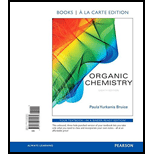
(a)
Interpretation:
The coenzyme transfers an acyl group from one substrate to another should be determined.
Concept introduction:
Cofactors that are organic molecule are called coenzymes;
Coenzymes are derived from Vitamins which are substance needed in small amounts for normal body function that the body cannot synthesize in adequate amounts.
Thiamine pyrophosphate (TPP) is the coenzyme required by enzymes that catalyse the transfer of an acyl group.
(b)
Interpretation:
The function of FAD on the pyruvate dehydrogenase complex should be determined.
Concept introduction:
Cofactors that are organic molecule are called coenzymes;
Coenzymes are derived from Vitamins which are substance needed in small amounts for normal body function that the body cannot synthesize in adequate amounts.
(c)
Interpretation:
The function of
Concept introduction:
Cofactors that are organic molecule are called coenzymes;
Coenzymes are derived from Vitamins which are substance needed in small amounts for normal body function that the body cannot synthesize in adequate amounts.
(d)
Interpretation:
The reaction necessary for proper blood clotting is catalysed by vitamin KH2 should be determined.
Concept introduction:
Cofactors that are organic molecule are called coenzymes;
Coenzymes are derived from Vitamins which are substance needed in small amounts for normal body function that the body cannot synthesize in adequate amounts.
(e)
Interpretation:
The coenzyme are used for decarboxylation reaction should be determined.
Concept introduction:
Cofactors that are organic molecule are called coenzymes;
Coenzymes are derived from Vitamins which are substance needed in small amounts for normal body function that the body cannot synthesize in adequate amounts.
(f)
Interpretation:
The various kinds of substrates should be determined for the decarboxylation coenzyme work on.
Concept introduction:
Cofactors that are organic molecule are called coenzymes;
Coenzymes are derived from Vitamins which are substance needed in small amounts for normal body function that the body cannot synthesize in adequate amounts.
(g)
Interpretation:
The coenzyme should be determined for carboxylation reaction.
Concept introduction:
Cofactors that are organic molecule are called coenzymes;
Coenzymes are derived from Vitamins which are substance needed in small amounts for normal body function that the body cannot synthesize in adequate amounts.
(h)
Interpretation:
The various kinds of substrates should be determined for the decarboxylation coenzyme work on
Concept introduction:
Cofactors that are organic molecule are called coenzymes;
Coenzymes are derived from Vitamins which are substance needed in small amounts for normal body function that the body cannot synthesize in adequate amounts.
Want to see the full answer?
Check out a sample textbook solution
Chapter 23 Solutions
Organic Chemistry, Books a la Carte Edition (8th Edition)
- Provide the structure, circle or draw, of the monomeric unit found in the biological polymeric materials given below. HO OH amylose OH OH 행 3 HO cellulose OH OH OH Ho HOarrow_forwardWhat units (if any) does K have? Does K depend upon how the concentration is expressed (e.g. molarity, ppm, ppb, etc.)? in calculating the response factorarrow_forwardDon't used hand raiting and don't used Ai solutionarrow_forward
- Don't used Ai solution and don't used hand raitingarrow_forwardOA. For the structure shown, rank the bond lengths (labeled a, b and c) from shortest to longest. Place your answer in the box. Only the answer in the box will be graded. (2 points) H -CH3 THe b Нarrow_forwardDon't used hand raitingarrow_forward
- Quizzes - Gen Organic & Biological Che... ☆ myd21.lcc.edu + O G screenshot on mac - Google Search savings hulu youtube google disney+ HBO zlib Homework Hel...s | bartleby cell bio book Yuzu Reader: Chemistry G periodic table - Google Search b Home | bartleby 0:33:26 remaining CHEM 120 Chapter 5_Quiz 3 Page 1: 1 > 2 > 3 > 6 ¦ 5 > 4 > 7 ¦ 1 1 10 8 ¦ 9 a ¦ -- Quiz Information silicon-27 A doctor gives a patient 0.01 mC i of beta radiation. How many beta particles would the patient receive in I minute? (1 Ci = 3.7 x 10 10 d/s) Question 5 (1 point) Saved Listen 2.22 x 107 222 x 108 3.7 x 108 2.22 x 108 none of the above Question 6 (1 point) Listen The recommended dosage of 1-131 for a test is 4.2 μCi per kg of body mass. How many millicuries should be given to a 55 kg patient? (1 mCi = 1000 μСi)? 230 mCiarrow_forwardDon't used hand raiting and don't used Ai solutionarrow_forwardDon't used hand raiting and don't used Ai solutionarrow_forward
- Q3: Arrange each group of compounds from fastest SN2 reaction rate to slowest SN2 reaction rate. CI Cl H3C-Cl CI a) A B C D Br Br b) A B C Br H3C-Br Darrow_forwardQ4: Rank the relative nucleophilicity of halide ions in water solution and DMF solution, respectively. F CI Br | Q5: Determine which of the substrates will and will not react with NaSCH3 in an SN2 reaction to have a reasonable yield of product. NH2 Br Br Br .OH Brarrow_forwardClassify each molecule as optically active or inactive. Determine the configuration at each H соон Chirality center OH 애 He OH H3C Ноос H H COOH A K B.arrow_forward
 Chemistry for Today: General, Organic, and Bioche...ChemistryISBN:9781305960060Author:Spencer L. Seager, Michael R. Slabaugh, Maren S. HansenPublisher:Cengage Learning
Chemistry for Today: General, Organic, and Bioche...ChemistryISBN:9781305960060Author:Spencer L. Seager, Michael R. Slabaugh, Maren S. HansenPublisher:Cengage Learning Introduction to General, Organic and BiochemistryChemistryISBN:9781285869759Author:Frederick A. Bettelheim, William H. Brown, Mary K. Campbell, Shawn O. Farrell, Omar TorresPublisher:Cengage Learning
Introduction to General, Organic and BiochemistryChemistryISBN:9781285869759Author:Frederick A. Bettelheim, William H. Brown, Mary K. Campbell, Shawn O. Farrell, Omar TorresPublisher:Cengage Learning General, Organic, and Biological ChemistryChemistryISBN:9781285853918Author:H. Stephen StokerPublisher:Cengage Learning
General, Organic, and Biological ChemistryChemistryISBN:9781285853918Author:H. Stephen StokerPublisher:Cengage Learning Organic And Biological ChemistryChemistryISBN:9781305081079Author:STOKER, H. Stephen (howard Stephen)Publisher:Cengage Learning,
Organic And Biological ChemistryChemistryISBN:9781305081079Author:STOKER, H. Stephen (howard Stephen)Publisher:Cengage Learning,






